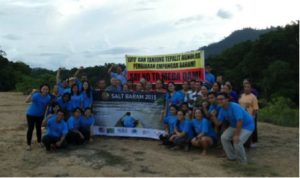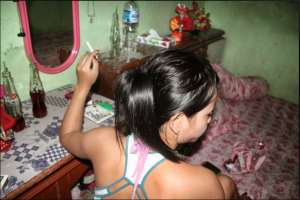By Mark Woodward
Hate speech is a common, but incompletely understood kind of contentious discourse. The term hate speech is most commonly used to describe disparaging remarks about ethnic,racial and religious minorities and LGBT communities. Basically, hate speech applies extremely negative stereotypes to individuals and groups not because of what they do or say, but because of who they are. It contributes to and is used to justify, racism, sectarianism, discrimination, social ostrasization,violence and even genocide.
Hate speech is like pornography. It is easy to recognize and hard to define. Hate“speech” can be more than talk and does not always rely on language. Some of the most virulent forms of hate speech are actually symbols, graphics, cartoons,videos and photo-shopped images.
There are no internationally accepted standards for defining hate speech, let alone for distinguishing the merely disgusting from the life threatening. Extreme cases in which speakers call on people to kill others or drive them from their homes are easy to spot. Others, which make symbolic associations between people and dangerous, despised beings, substances, entities, diseases, behaviors or objects,are not so clear. The absences of standards make it difficult to control hate speech, especially in countries where freedom of speech is greatly valued and legally protected.
Some countries have strict hate speech laws with severe punishments for offenders.Others have none. In Canada advocating genocide or hatred of “any section of the public distinguished by colour, race, religion, ethnic origin or sexual orientation” is punishable by as much as fourteen years behind bars. Just across the border in the United States, there are no hate speech laws. In the US it is legal to refer to the president as a “subhuman mongrel,” a term Nazi’s used to describe Jews, Romani and other people they targeted for extermination. In Indonesia hate speech is unrestricted.
In all but the most extreme cases linguistic and cultural subtleties make hate speech hard to define. For example, to call someone a “fat pig” is insulting,especially if he/she is Jewish or Muslim — but it is hardly hate speech. To say “all of those people are fat pigs” may be another story. Hate speech can also be culturally specific. Some words and expressions are vitriolic in some societal context but nearly meaningless in others. In Indonesia, referring to people as “cancer” is hate speech especially when coupled with the expression “which must be removed.” In the United States calling people cancer wouldn’t make cultural sense and could hardly be thought of as hate speech.
In this essay I draw on my experience with the Indonesian Islamic Defenders Front(FPI). There is nothing exceptional about FPI. It is a band of thugs with an articulate, charismatic leadership that uses hate speech and violence to intimidate ethnic and religious minorities. Unfortunately there are similar groups in many other countries. FPI is just the one I know best.
Two examples of FPI rhetoric show how difficult distinguishing the merely disgusting from the dangerous can be. In a video posted on YouTube in 2008 FPI leader Sobri Lubis says:
We call on the Muslim community. Let us go to war with Ahmadiyah! Kill Ahmadiyah wherever they are! God is great! God is great! Kill! Kill! Kill! :http://www.youtube.com/watch?v=ynunOMEtUmg
This is hate speech. Worse still, it is lethal hate speech because rank and file FPI members have killed Ahmadiyah Muslims and savagely beaten others.
This poster located just outside FPI headquarters in Jakarta is more ambiguous.
[caption id="attachment_3149" align="alignright" width="180"] Indonesia peace without liberals[/caption]
If it were to be displayed by a non-violent organization it would be contentious political discourse. Displayed by FPI it is more sinister because the word “without” carries a thinly veiled threat of violence. In books and on other posters FPI describes “liberals” including many of Indonesia’s most respected Muslim intellectuals as “more satanic that Satan.” That is definitely hate speech.
Understanding Hate Speech
What follows is a model for understanding the difference between hate speech and contentious civil discourse. Like all models it is reductionist. But reductionism is a kind of explanation that helps us make sense of ambiguity and complexity. We can locate contentious discourse and hate speech on a five-point scale measuring the degree to which an individual or group endorses symbolic or physical violence.
1. Discussion and even argument about differences — as long as it is conducted in civil terms.
2. Unilateral condemnation of others.
3. Dehumanization of others.
4. Demonization of others.
5. Explicit provocation of violence.
Levels1 and 2 are civil discourse because they do not implicitly or explicitly threaten violence. Levels 3 through 5 are hate speech. They make threatening,hurtful symbolic associations and are inherently dangerous. They are psychological violence that can easily lead to physical violence.
Dehumanization and demonization require some explanation. They are the psychological concepts drawn from the literature on rumors and collective violence. The are the keys for distinguishing between civil contentious discourse and hate speech.
Dehumanization is a psycho-symbolic process that defines others as less than fully human. They are said to lack some combination of valued human qualities such as agency,independence, compassion, consideration for others, honesty, dignity and restraint. It can also be referring to them as non-human beings.
Psychologists distinguish between self and other directed dehumanization. Other directed dehumanization makes negative judgments about others. Calling groups of people lazy, greedy, deviant, perverted, dishonest (among other things) or referring to them as dogs, pigs, rats, lice, vultures (among other animals) are but a few examples. Self directed dehumanization is a sense of real or imagined disempowerment in the faceof real or imagined overwhelming force. Hate speech often defines the speaker and her/his community as powerless victims, even if they are not. Ironically as powerless victims, they are entitled to use extreme measures to “defend”themselves against subhuman others. Hence the claim that because we cannot contain threatening “deviants” by ordinary means, using violence against them is morally justified. This is the type of logic FPI uses to justify attacks on Ahmadiyah Muslims and other minorities.This is twisted logic and hate speech is twisted logic. It often appears to be logical and never actually is.
Demonization is an extreme, and especially dangerous form of other directed dehumanization.It defines “enemy others” as existential threats and if religious language is used, as the embodiment of evil. Demonization involves the projection of deeply seated fears or archetypes of evil onto opponents.
Sometimes demonization is literal. FPI, for example, adds the name “Iblis” (the devil) to those of its long list of designated enemy others. At others it is slightly subtler, referring to enemy others in ideological terms or as life threatening diseases. Existential threats take symbolic forms suited to the context in which hate speech is located. Communist on Wall Street, Satan in the Vatican and Malaria in Sub-Saharan Africa have similar meanings.
FPI Demonization
Indonesia peace without liberals[/caption]
If it were to be displayed by a non-violent organization it would be contentious political discourse. Displayed by FPI it is more sinister because the word “without” carries a thinly veiled threat of violence. In books and on other posters FPI describes “liberals” including many of Indonesia’s most respected Muslim intellectuals as “more satanic that Satan.” That is definitely hate speech.
Understanding Hate Speech
What follows is a model for understanding the difference between hate speech and contentious civil discourse. Like all models it is reductionist. But reductionism is a kind of explanation that helps us make sense of ambiguity and complexity. We can locate contentious discourse and hate speech on a five-point scale measuring the degree to which an individual or group endorses symbolic or physical violence.
1. Discussion and even argument about differences — as long as it is conducted in civil terms.
2. Unilateral condemnation of others.
3. Dehumanization of others.
4. Demonization of others.
5. Explicit provocation of violence.
Levels1 and 2 are civil discourse because they do not implicitly or explicitly threaten violence. Levels 3 through 5 are hate speech. They make threatening,hurtful symbolic associations and are inherently dangerous. They are psychological violence that can easily lead to physical violence.
Dehumanization and demonization require some explanation. They are the psychological concepts drawn from the literature on rumors and collective violence. The are the keys for distinguishing between civil contentious discourse and hate speech.
Dehumanization is a psycho-symbolic process that defines others as less than fully human. They are said to lack some combination of valued human qualities such as agency,independence, compassion, consideration for others, honesty, dignity and restraint. It can also be referring to them as non-human beings.
Psychologists distinguish between self and other directed dehumanization. Other directed dehumanization makes negative judgments about others. Calling groups of people lazy, greedy, deviant, perverted, dishonest (among other things) or referring to them as dogs, pigs, rats, lice, vultures (among other animals) are but a few examples. Self directed dehumanization is a sense of real or imagined disempowerment in the faceof real or imagined overwhelming force. Hate speech often defines the speaker and her/his community as powerless victims, even if they are not. Ironically as powerless victims, they are entitled to use extreme measures to “defend”themselves against subhuman others. Hence the claim that because we cannot contain threatening “deviants” by ordinary means, using violence against them is morally justified. This is the type of logic FPI uses to justify attacks on Ahmadiyah Muslims and other minorities.This is twisted logic and hate speech is twisted logic. It often appears to be logical and never actually is.
Demonization is an extreme, and especially dangerous form of other directed dehumanization.It defines “enemy others” as existential threats and if religious language is used, as the embodiment of evil. Demonization involves the projection of deeply seated fears or archetypes of evil onto opponents.
Sometimes demonization is literal. FPI, for example, adds the name “Iblis” (the devil) to those of its long list of designated enemy others. At others it is slightly subtler, referring to enemy others in ideological terms or as life threatening diseases. Existential threats take symbolic forms suited to the context in which hate speech is located. Communist on Wall Street, Satan in the Vatican and Malaria in Sub-Saharan Africa have similar meanings.
FPI Demonization
 This poster is also on display at FPI’s Jakarta headquarters. It is a graphic example of the literal demonization of enemy others. It show FPI leader Rizieq Shihab and an FPI fighter confronting a band of demons that includes Mizra Ghulam, the founder of the Ahmadiyah movement and many prominent Indonesian intellectuals all of whom are described as satanic, deviant, apostate, idiotic,unbelievers. It is hard to imagine a clearer example of demonization based hate speech.
Level four hate speech, falls just short of calling for physical violence. It typically includes some or all of the following claims:
1. The other is inherently evil.
2. This evil poses an existential threat.
3. The other cannot or will not change.
4. Therefore,the other must be destroyed.
5. Destruction of the other is virtuous.
Conflict stemming from or justified in terms of demonization based hate speech is what Mark Juergensmeyer calls “cosmic war.”It is a zero sum game, in which compromise and negotiation are impossible. Hate speech does not inevitably lead to physical violence but establishes conditions in which people are convinced that violence is justified. It can create a climate of irrational fear that leads people who would not engage in violence themselves to condone it and to support discrimination and other forms of symbolic violence. FPI, Indonesia and Ahmadiyah provide a tragic example. A decade ago few Indonesians had ever heard of the Ahmadiyah. An unending barrage of hate speech from FPI and its allies has led a majority to conclude that Ahmadiyah should be outlawed.
Combating Hate Speech
Hate speech legislation may be well intended but it is unlikely to be successful. In countries where it exists hate mongers skirt the edges of the law or gounder ground, often via the inter-net. Social networking sites have become havens for hate speech.
Attempting to engage purveyors of hate speech is debate or rational discourse is futile. This is an example of how they typically respond.
Two years ago a colleague and I attempted to have a “dialog” with FPI activists when they stormed into our office. They told us that they wanted to have a dialog and we agreed. FPI’s idea of dialog is “we talk, you listen and comply with our demands — or else.” They screamed “No photos” as they photographed usand our students. We photographed them as they marched down the stairs.
Non-violent hate mongers change the subject, restate their positions in slightly less offensive terms, deny that they are spreading hate or fall back on self directed dehumanization — presenting themselves as victims, martyrs and misunderstood defenders of public virtue. FPI describes itself as the victim of the liberal press.
What can work is to publicly hold the purveyors of hate speech accountable for their words and actions; to call them out for what they are; and to expose the absurdity of the claims they make. Journalists, bloggers, religious and community leaders all have roles to play in this process. So do ordinary citizens and netizens. Taking up the pen, switching on the word processor, speaking from the pulpit on the air and on line are steps to take. When and where possible,non-violent demonstrations and other public events are good things to do.
This is an example. On May 9th 2012 elements of FPI and its ally the Indonesian Jihad Fighters Council (MMI) attacked a book launching featuring Canadian Muslim feminist Irshad Manji. They distributed hate speech leaflets, denounced Ms Manji as a perverted deviant, beat up some members of the audience and threatened to kill everyone.
The next morning a group of activists representing civil society and Muslim organizations gathered to organize a response. The outcome was a grand coalition united by opposition to hate speech and violence. It included student groups from several universities, women’s organizations, royalists, ethnic organizations, traditionalist Muslims, non-violent Islamists and others. On May 11th ten thousand people marched to demand an end to hate speech and violence.
The Yogyakarta People’s Anti-Violence Movement
This poster is also on display at FPI’s Jakarta headquarters. It is a graphic example of the literal demonization of enemy others. It show FPI leader Rizieq Shihab and an FPI fighter confronting a band of demons that includes Mizra Ghulam, the founder of the Ahmadiyah movement and many prominent Indonesian intellectuals all of whom are described as satanic, deviant, apostate, idiotic,unbelievers. It is hard to imagine a clearer example of demonization based hate speech.
Level four hate speech, falls just short of calling for physical violence. It typically includes some or all of the following claims:
1. The other is inherently evil.
2. This evil poses an existential threat.
3. The other cannot or will not change.
4. Therefore,the other must be destroyed.
5. Destruction of the other is virtuous.
Conflict stemming from or justified in terms of demonization based hate speech is what Mark Juergensmeyer calls “cosmic war.”It is a zero sum game, in which compromise and negotiation are impossible. Hate speech does not inevitably lead to physical violence but establishes conditions in which people are convinced that violence is justified. It can create a climate of irrational fear that leads people who would not engage in violence themselves to condone it and to support discrimination and other forms of symbolic violence. FPI, Indonesia and Ahmadiyah provide a tragic example. A decade ago few Indonesians had ever heard of the Ahmadiyah. An unending barrage of hate speech from FPI and its allies has led a majority to conclude that Ahmadiyah should be outlawed.
Combating Hate Speech
Hate speech legislation may be well intended but it is unlikely to be successful. In countries where it exists hate mongers skirt the edges of the law or gounder ground, often via the inter-net. Social networking sites have become havens for hate speech.
Attempting to engage purveyors of hate speech is debate or rational discourse is futile. This is an example of how they typically respond.
Two years ago a colleague and I attempted to have a “dialog” with FPI activists when they stormed into our office. They told us that they wanted to have a dialog and we agreed. FPI’s idea of dialog is “we talk, you listen and comply with our demands — or else.” They screamed “No photos” as they photographed usand our students. We photographed them as they marched down the stairs.
Non-violent hate mongers change the subject, restate their positions in slightly less offensive terms, deny that they are spreading hate or fall back on self directed dehumanization — presenting themselves as victims, martyrs and misunderstood defenders of public virtue. FPI describes itself as the victim of the liberal press.
What can work is to publicly hold the purveyors of hate speech accountable for their words and actions; to call them out for what they are; and to expose the absurdity of the claims they make. Journalists, bloggers, religious and community leaders all have roles to play in this process. So do ordinary citizens and netizens. Taking up the pen, switching on the word processor, speaking from the pulpit on the air and on line are steps to take. When and where possible,non-violent demonstrations and other public events are good things to do.
This is an example. On May 9th 2012 elements of FPI and its ally the Indonesian Jihad Fighters Council (MMI) attacked a book launching featuring Canadian Muslim feminist Irshad Manji. They distributed hate speech leaflets, denounced Ms Manji as a perverted deviant, beat up some members of the audience and threatened to kill everyone.
The next morning a group of activists representing civil society and Muslim organizations gathered to organize a response. The outcome was a grand coalition united by opposition to hate speech and violence. It included student groups from several universities, women’s organizations, royalists, ethnic organizations, traditionalist Muslims, non-violent Islamists and others. On May 11th ten thousand people marched to demand an end to hate speech and violence.
The Yogyakarta People’s Anti-Violence Movement
 This banner reads: “Yogyakarta People’s Anti-Violence Movement. Yogya a Special Place with a Peaceful and Secure Heart. Yogyakarta City of Tolerance.”
This was a small step on a long road. It sent FPI MMI and their friends a message that there will be responses to hate speech and violence. The demonstration was nationally televised reaching a potential viewership of tens of millions with the message “Say no to hate speech and violence.”
About the author: Mark Woodward is Associate Professor of Religious Studies and is also affiliated with the Center for the Study of Religion and Conflict at Arizona State University. He is currently Visiting Professor of Comparative Religion at Gadjah Mada University and Sunan Kalijaga State Islamic University in Indonesia. In 2008 he was Visiting Associate Professor at the S. Rajaratnam School of International Studies, Nanyang Technological University in Singapore. He has a B.A., M.A. and Ph.D. in anthropology from the University of Illinois Urbana-Champaign. His research focuses on religion-state-society relations and religion and conflict in Southeast Asia. He is author of Islam in Java. Normative Piety and Mysticism in the Sultanate of Yogyakarta, Defenders of Reason in Islam (1989)and Java, Indonesia and Islam (2010) co-author (with Richard Martin and Dwi Atmaja) ofDefenders of Reason in Islam. Mutazilism from Medieval School to Modern Symbol (1997) and editor of Towards a New Paradigm: Intellectual Developments in Indonesian Islam (1996). He has published more than fifty scholarly articles in the US, Europe, Indonesia and Singapore, many co-authored with Southeast Asian scholars. He his currently directing a trans-disciplinary, multi-country project on counter-radical Muslim discourse.
This banner reads: “Yogyakarta People’s Anti-Violence Movement. Yogya a Special Place with a Peaceful and Secure Heart. Yogyakarta City of Tolerance.”
This was a small step on a long road. It sent FPI MMI and their friends a message that there will be responses to hate speech and violence. The demonstration was nationally televised reaching a potential viewership of tens of millions with the message “Say no to hate speech and violence.”
About the author: Mark Woodward is Associate Professor of Religious Studies and is also affiliated with the Center for the Study of Religion and Conflict at Arizona State University. He is currently Visiting Professor of Comparative Religion at Gadjah Mada University and Sunan Kalijaga State Islamic University in Indonesia. In 2008 he was Visiting Associate Professor at the S. Rajaratnam School of International Studies, Nanyang Technological University in Singapore. He has a B.A., M.A. and Ph.D. in anthropology from the University of Illinois Urbana-Champaign. His research focuses on religion-state-society relations and religion and conflict in Southeast Asia. He is author of Islam in Java. Normative Piety and Mysticism in the Sultanate of Yogyakarta, Defenders of Reason in Islam (1989)and Java, Indonesia and Islam (2010) co-author (with Richard Martin and Dwi Atmaja) ofDefenders of Reason in Islam. Mutazilism from Medieval School to Modern Symbol (1997) and editor of Towards a New Paradigm: Intellectual Developments in Indonesian Islam (1996). He has published more than fifty scholarly articles in the US, Europe, Indonesia and Singapore, many co-authored with Southeast Asian scholars. He his currently directing a trans-disciplinary, multi-country project on counter-radical Muslim discourse.





